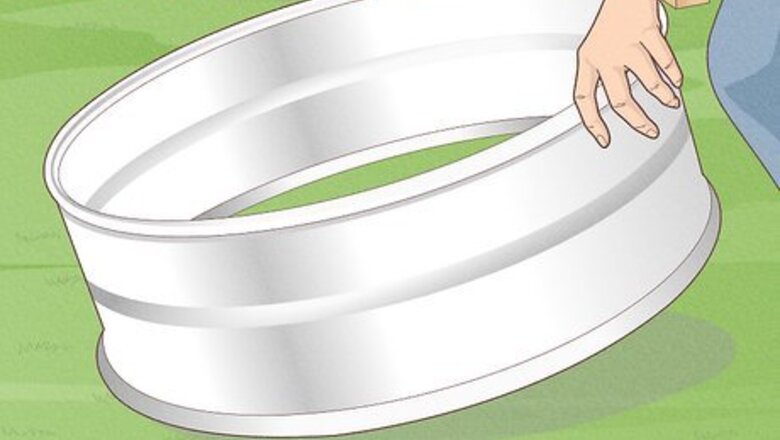
views
- Use pavers, a steel stock tank ring, and crushed stone to build a sturdy smokeless pit over concrete.
- Try a Dakota fire hole if you're camping or need a temporary solution. Dig a hole in dry ground, then dig a second feeder hole and connect both holes.
- Avoid building a fire pit on on pea gravel or river rocks. These materials can explode when they get hot due to moisture retention.
Building a Smokeless Pit Out of Pavers

Buy a steel stock tank ring to make the inner core. Steel stock tank rings, also known as fire rings, are galvanized steel circles that people use to make simple fire pits (they’re also popular as raised flower beds). They come in a variety of sizes, so purchase a ring that matches the size you want the fire pit to be. You can purchase a steel stock tank ring online or from a tractor supply store. They may also be available at your local gardening or building supply store. Make sure that the steel stock ring is hollow. Some of the planter variations have solid bottoms, but those won’t work for this. A ring that’s roughly 3 feet (0.91 m) wide and 1 ft (0.30 m) high would work as an excellent fire pit.
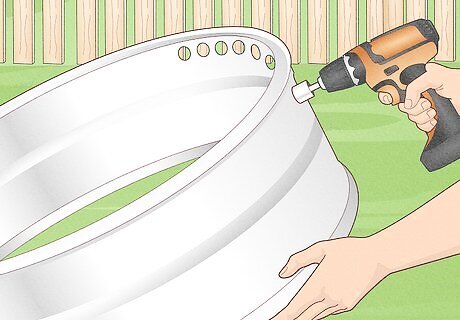
Drill holes in a circle around the upper edge of the ring. Grab a 1–2 in (2.5–5.1 cm) hole saw and attach it to your drill. Roughly 1–3 inches (2.5–7.6 cm) from the top of the ring, drill a hole into the tank ring. Then, drill an identical hole next to it. Continue working your way around the rim of the tank ring in a circle. You don’t need to take exact measurements, but aim to place each hole you drill roughly 2 inches (5.1 cm) away from one another. Wear protective eyewear. Drilling into the tank ring may send metal shavings flying. The holes will sit at the top of the fire pit. Just keep that in mind as you keep going. So long as the holes are in a symmetrical circle at the top of the tank ring, their size and distance between one another doesn’t matter.

Sand the holes down to make the ring safe to touch. There will be a lot rough metal edges where you drilled the holes, so grab an orbital sander and turn it on the lowest setting. Slowly work your way around the holes you drilled with the sandpaper to smooth them down and dull any sharp edges. Keep your eyewear on for this. A stray metal shaving may fly off while you’re sanding. This isn’t technically mandatory; it just makes the tank ring safe to touch and move around. If you never plan on moving the tank, feel free to skip this.
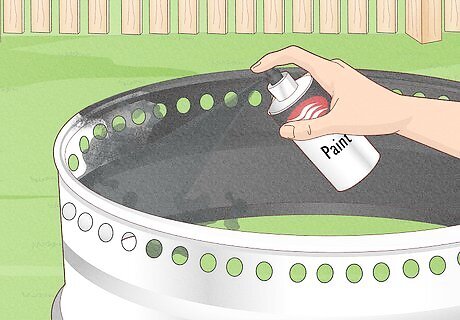
Paint the inside of the ring for a unique look using spray paint. If you’re fine with the metal look of the galvanized steel, leave it the way it is. But if you’d like to paint the inside of the pit, grab a spray paint designed specifically for high heat conditions. Shake the can up, hold it 12–16 inches (30–41 cm) from the metal, and spray the inside of the tank ring using smooth, even strokes. You can find heat-resistant spray paint at most home improvement stores or online. It may take multiple coats to get an opaque coat. Wait at least 1 hour between coats. Black and brown will both look good, but fancier, brighter colors are likely to get dirty very quickly.
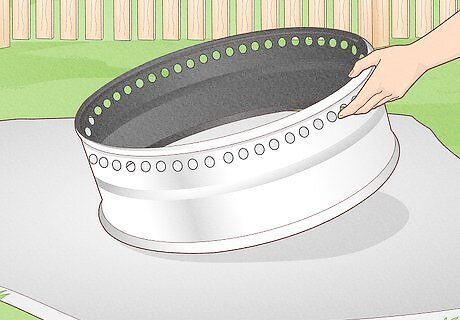
Set your stock ring where you plan on installing the fire pit. So long as the ground is flat, fire-resistant, and nowhere near your home, it should work. If there’s a concrete slab you’ve got nearby, that should work. If your yard is all grass, lay pavers down where you plan on installing the pit. Any heat-resistant material works, but traditional brick, stone, concrete, granite, and flagstone are all ideal. Do not set your fire pit on pea gravel or river rocks. These materials can retain moisture and explode when they heat up. If you have to install pavers, check with your utility companies before you dig anything out to avoid hitting a gas or water line.
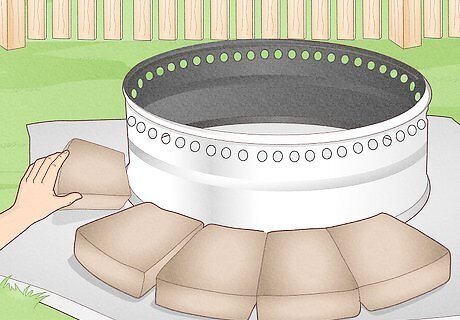
Stack one layer of pavers in a circle around your stock tank ring. Leave a gap of roughly 1–2 inches (2.5–5.1 cm) between the outside of the tank ring and the interior edge of the stone. That gap must remain as you build your way up. When you burn your fire, the smoke will flow through the holes you drilled in the tank ring and into this gap. Complete a single row of pavers on the ground around the tank ring. You can use fire bricks or fire cement blocks instead of pavers if you’d like. The most popular stones for this are tapered a bit along the sides so that you can stack them in a tighter circle.
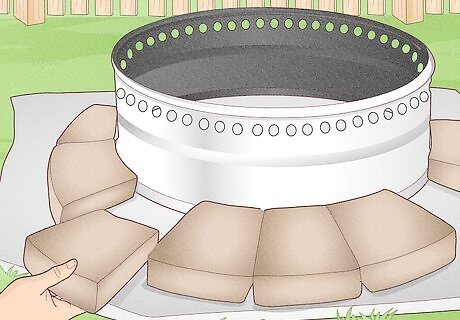
Remove 3 of the pavers at the bottom of the circle. You need cold air to enter the gap between the stone and the tank ring. To let this cold air in, remove 3 equidistant stones from your bottom row of pavers so that there are gaps between the stones. Alternatively, you remove a single paver and then space all of the other stones out evenly to leave a 1–2 in (2.5–5.1 cm) gap between every single paver.
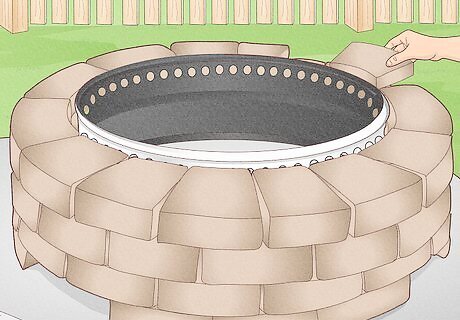
Continue stacking the pavers until they reach the top of the ring. Lay your next row of pavers so that the center of each stone rests on top of the seam between two stones below it. That way, when you reach the gaps where you removed the pavers, two stones will meet evenly in the middle. Keep stacking the pavers up until you reach the rim of the tank ring.
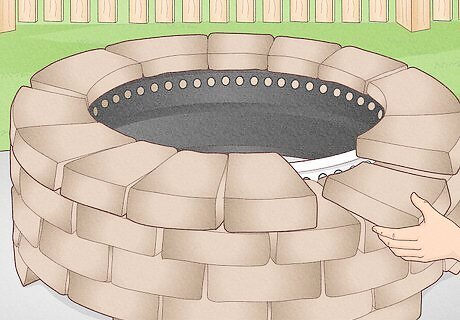
Lay wider pavers on top to cover the gap for a cohesive look. Once you’ve reached the top of the tank ring, confirm that the 1–2 in (2.5–5.1 cm) gap between the ring and the pavers is still there. Then, cover the opening at the top by laying a row of larger pavers. This will close the gap and create the opening you need to burn fires without the smoke. The openings at the bottom allow cold air in. That cold air travels up and gets heated quickly from the fire. The holes in the ring will draw air from the fire into the opening as the cold air pulls it down, thus removing the smoke.
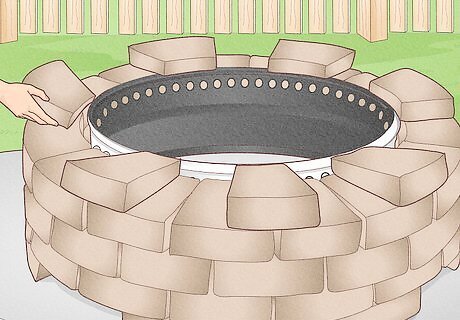
Use the same pavers and remove one to for a tapered style. If you don’t have larger pavers or you want to use the same stone, use one fewer stone at the top row so that the bricks sit closer to the middle of the tank ring. This will also give your fire pit a bit of a tighter look at the top. So long as the gap between the tank ring and the exterior stone is covered, you’re good to go. This will work just as well as larger pavers, so choose whichever look you prefer.
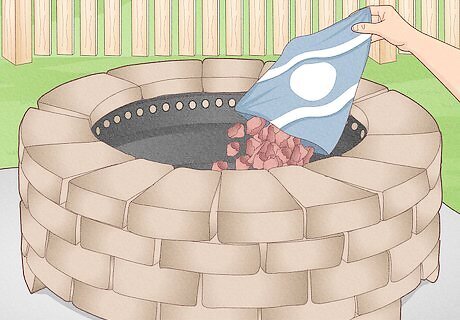
Fill in the bottom of the fire pit with crushed fireproof stone. Any kind of large, fire-safe stone will work for this (lava rock is perfect). Fill in the bottom of your pit with the stone and spread it out by hand or a trowel so that it’s even. This will give your wood some room to breathe so that plenty of oxygen can feed your fire. Pea gravel and river stone are absolute no-gos. They retain too much moisture and can explode if you start a fire when it’s wet. You can now use your fire pit and enjoy the smokeless flames!
Digging a Dakota Fire Hole
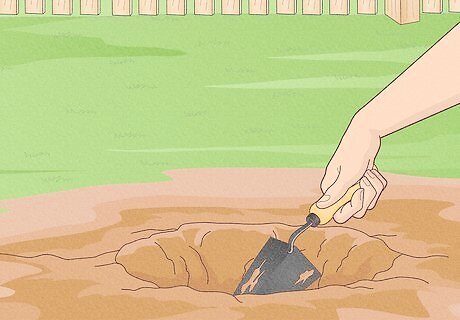
Dig a hole that’s roughly 12–16 inches (30–41 cm) deep in dry soil. Aim to make the opening slightly smaller than the hole, especially if you plan on cooking anything over the fire hole. Dig straight down and use a trowel to shape the hole as needed. If you are cooking over the fire hole, the width of the hole must be smaller than your pot or skillet. Place the hole under a tree canopy to disperse the smoke even better. The Dakota fire hole will minimize smoke, but it won’t be 100% smokeless. This will not work if there is no wind or it rained recently and the soil is wet.
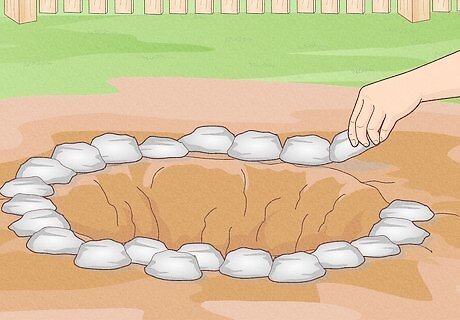
Line the edges of the opening with stones if you’re cooking. If you plan on cooking any food over the hole, gather small stones and rocks. Line the edges of the hole you’ve dug with the stones and try to keep them at roughly the same height so your pot or pan rests evenly. This will allow heat to escape through the gaps in the rocks as you cook so that your hole doesn’t explode. If you don’t have access to rocks, you can lay thick branches around the rim of the hole if you prefer.
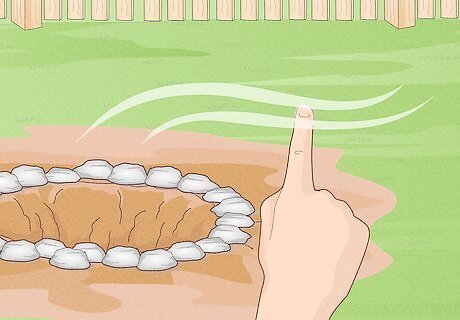
Identify where the wind is coming from. The quickest way to figure out the direction of the wind is to wet your finger and hold it up. The side that dries faster and feels colder is where the wind is coming from. Alternatively, you can turn your face slowly until you feel the wind in your eyes, or hold a small strip of fabric up to see where it blows.
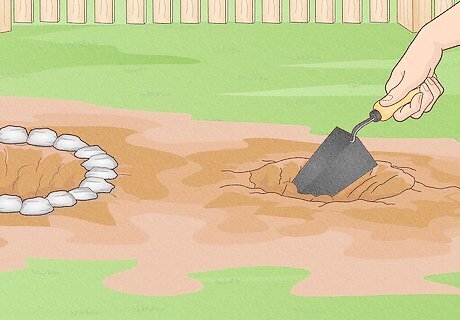
Dig a feeder hole in the wind’s direction at a 45-degree angle. Go 10–16 inches (25–41 cm) away from the hole you’ve dug in the direction where the wind is blowing from. Grab your shovel and get started on a second hole that’s roughly 8 inches (20 cm) wide. Dig at a roughly 45-degree angle towards the bottom of the first hole you’ve dug. This second hole will feed air into the bottom of the first hole you’ve dug. That will feed the fire with oxygen and cold air, which should burn the fire while dissipating much of the smoke.

Connect the two holes underground. Continue digging with your trowel or shovel until you reach the bottom of the first hole. If you don’t hit the bottom perfectly, fill in the hole with a little more dirt to make the bottom level. If you dig underneath the hole, go back to the first hole and dig a little deeper until you find the connection.
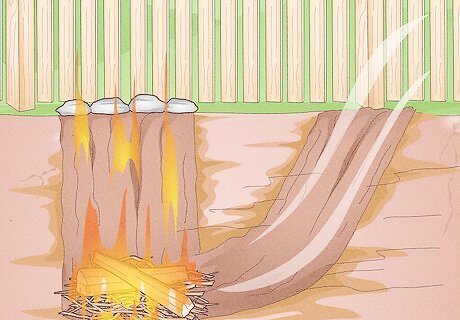
Start a small fire in the bottom of the vertical pit. Grab your twigs, kindling, and other starter material and fill in the bottom of the first hole you’ve dug. Stack your wood on top and light the fire. The air from the feeder hole will help the fire start while blowing away some of the smoke before it even has a chance to leave the hole.




















Comments
0 comment